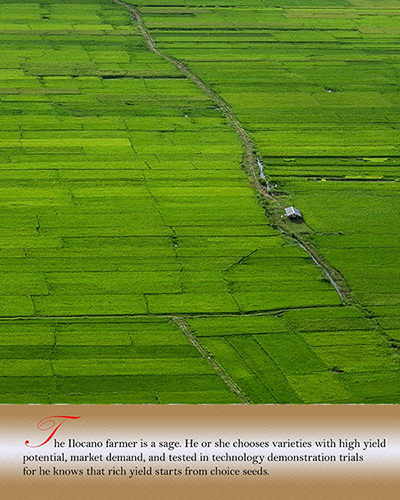Farmers’ achievement in the unfavorable condition is shown through a month-long exhibit spearheaded by the Rice Science Museum of Philippine Rice Research Institute (PhilRice). 
Launched on November 25 at Balay Dingras in Ilocos Norte, the exhibit titled, Balligi ni Mannalon (Farmers’ Victory), features photo stories showing the traits of the Ilocano farmers and the role of women in rice farming. These traits include being wise, patient, meticulous, and resourceful.
“Our province is a three-time Agri-Pinoy Rice Achiever awardee and we attribute this accomplishment to our extraordinarily hardworking farmers. Despite harsh situations, they are able to provide enough rice for the province,” Norma Lagmay, provincial agricultural officer, said.
Ilocos Norte, known for its semi-arid lands and strong typhoon occurrences, is one of the provinces with a rice self-sufficiency level of more than 200%.
As “livable, resilient, and sustainable” province, agriculture in Ilocos Norte is among the most productive in the country and has a very low poverty incidence at 9.9%, which is far lower than the national average of 25.2% in 2012.
Event organizer Maribel Alupay said that the exhibit is inspiring other farmers to improve their harvest as the queries on new technologies and rice varieties used by Ilocano farmers are increasing.
“Unlike ordinary photo exhibitions, this activity is complemented with cultural materials and displays on local farming practices,” Alupay said.
The initiative, which will run until Dec. 31 in partnership with the provincial and municipal units, is part of the series of November exhibits for the National Rice Awareness Month (NRAM) to draw public’s attention on agriculture.
PhilRice, through its Department of Tourism-accredited museum, executed mobile exhibits highlighting rice farming technologies, brown and pigmented rices, and landowners’ and farmers’ fashion.
Covering offices, schools, and museums in Metro Manila, Nueva Ecija, and Ilocos Norte, the featured exhibits aim to foster good health behaviors from the public and engage the youth in rice farming.
“These activities are in support to this year’s NRAM, which focuses on mainstreaming brown rice as an alternative food staple to white rice. In going to offices and schools, we urge our audience, especially the youth, to start the habit of eating brown rice as it has more dietary fiber and antioxidants,” Diadem Esmero, Rice Science Museum senior curator, said.
The Rice Science Museum in partnership with the Ayala Museum and Central Luzon Agricultural Museum in Central Luzon State University (CLSU) also ran an exhibit titled, Evolution of Novo Ecijano’s Farming System and Filipino Costumes.
Implemented until Dec. 1 at CLSU, it featured a 42-year-old doll collection, which dramatizes the distinctive features of the Filipino clothes with some from farming communities.
“We hope that through photography, health, and fashion, the public will be more engaged in talking about agriculture and acting on its issues,” Esmero added.




